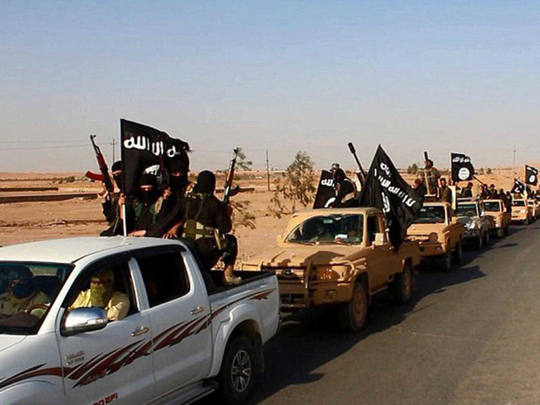
Beirut: Daesh has been driven from most of the swathes of territory it once held in Iraq and Syria, now reduced to pockets of the area that once formed its so-called “caliphate”.
Here is a look at the group’s emergence, its swift advances and subsequent defeats.
April 2013: Abu Bakr Al Baghdadi, head of the Al Qaida-linked Islamic State of Iraq (ISI), announces in an online recording the creation of a group called the Islamic State of Iraq and the Levant (Daesh).
In early 2014 Al Qaida disavows Daesh completely.
January 2014: Daesh conquers Syria’s northern city of Raqqa after fierce fighting with rival militants. It is the first provincial capital to fall from regime control and becomes the militants’ main stronghold.
In June they launch a rampage across northwestern Iraq, seizing second city Mosul and a belt of territory bordering the autonomous Kurdistan region. Tens of thousands of Christians and Yazidis, a religious minority, flee.
June 2014: Daesh declares a “caliphate” in territories it has seized in Iraq and Syria and declares its chief Al Baghdadi “caliph” and “leader of Muslims everywhere”.
A week later Al Baghdadi appears for the first time in a video posted on militant sites and calls on all Muslims to obey him.
August 2014: United States warplanes strike Daesh positions in northern Iraq in response to an appeal from the Iraqi government. It is Washington’s first direct military engagement in the country since it withdrew its troops in 2011.
In September an international coalition is formed to defeat the emboldened militant group. The US and Arab allies launch air strikes on Daesh positions in Syria.
January 2015: Daesh is driven from the Syrian border town of Kobani after more than four months of fighting led by Kurdish forces backed by coalition air strikes.
March 2015: Iraq announces the “liberation” of Tikrit, north of Baghdad. Daesh had controlled Tikrit for nearly 10 months. The operation involves Iran, via Shiite militias, and Washington, which heads the anti-militant coalition.
February 2016: Iraqi forces capture Ramadi, overrun by militants the previous May. In June, they retake Fallujah, which spent two and a half years out of their control.
August 2016: The Syrian Democratic Forces (SDF) coalition of Arab and Kurdish fighters backed by US air strikes recaptures the northern town of Manbij.
Turkish troops and Syrian rebels retake the border town of Jarabulus.
February 2017: The Turkish army announces it has taken full control of Al Bab, the last Daesh bastion in Aleppo province.
March 2017: Syrian troops backed by Russian jets complete the recapture of the historic city of Palmyra.
July 2017: Iraqi Prime Minister Haider Al Abadi announces the “liberation” of Mosul, the last urban stronghold of Daesh in Iraq, after a nearly nine-month offensive spearheaded a 30,000-strong federal force backed by coalition air strikes.
August 2017: Syrian regime forces recapture Al Sukhna, the last Daesh stronghold in Homs province and on the road to the eastern city of Deir Al Zor, where a government garrison has been under Daesh siege since early 2015.
October 2017: Al Abadi announces the recapture of Hawija, one of the few remaining Daesh holdouts.
October 2017: The SDF announces the full recapture of Raqqa after more than four months of fighting.
November 2017: Iraqi forces enter Al Qaim, the main town in the group’s last bastion in the country.
November 2017: Syria’s army seizes Deir Al Zor , driving the militants from the last major city where they had a presence.












